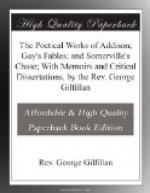Shortly after occurred his famous quarrel with Pope, to which we have already referred in our life of that poet, and do not intend to recur. Next year Addison’s long courtship came to a successful close. He wedded the Dowager Warwick, went to reside at Holland-house, and became miserable for life. She was a proud, imperious woman, who, instead of seeking to wean Addison from his convivial habits, (if such habits in any excessive measure were his,) drove him deeper into the slough by her bitter words and haughty carriage. The tavern, which had formerly been his occasional resort, became now his nightly refuge. In 1717 he received his highest civil honour, being made Secretary of State under Lord Sunderland; but, as usual, the slave soon appeared in the chariot. His health began to break down, and asthma soon obliged him to resign his office, on receiving a retiring pension of L1500 a-year. Next Steele and he, having taken opposite sides in politics, got engaged in a paper war—Steele in the Plebeian, and Addison in the Old Whig; and personalities of a disagreeable kind passed between the two friends. In the meantime Addison was dying fast. Dropsy had supervened on asthma, and the help of physicians was vain. He prepared himself, like a man and a Christian, to meet the last stern foe. He sent for Gay and asked his forgiveness for some act of unkindness he had done him. Gay granted it, although utterly ignorant of what the offence had been. He had probably, on account of his Toryism, been deprived, through Addison’s means, of some preferment. He entrusted his works to the care of Tickell, and dedicated them to Craggs, his successor in the secretaryship, in a touching and beautiful letter, written a few days before his death. He called, it is said, the young Earl of Warwick, his wife’s son, a very dissipated young man, and of unsettled religious principles, to his bedside, and said, “I have sent for you that you may see how a Christian can die.” He breathed his last on the 17th June 1709, forty-seven years old, and leaving one child, a daughter, who died, at an advanced age, at Bilton, Warwickshire, in 1797. His funeral took place, at dead of night, in Westminster Abbey, Bishop Atterbury meeting the procession and reading the service by torch-light. He was laid beside his friend Montague, and in a few months his successor, Craggs, was laid beside him. Nearly a century elapsed ere the present monument was erected over his dust. Tickell wrote a fine poem to his memory; and a splendid edition of his works was published by subscription in 1721.
Addison was cut off in the prime of life, and interrupted in some literary undertakings and projects of great pith and moment. He had written a portion of a treatise on the “Evidences of Christianity,” and was meditating some works, such as a “Metrical Version of the Psalms” and a tragedy on the history of Socrates, still more suitable to his cast of mind.




